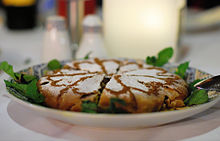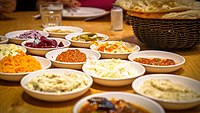Pastilla
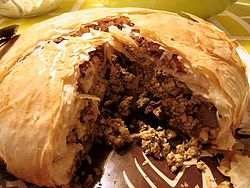 | |
| Alternative names | Pastel |
|---|---|
| Type | Meat pie |
| Place of origin | Al-Andalus |
| Region or state | Morocco, also Algeria, France, Israel, North America, Tunisia |
| Main ingredients | Warka dough, broth, spices; squab, chicken, fish or offal |
Pastilla (Moroccan Arabic: بسطيلة, romanized: basṭīla) is a traditional Moroccan dish in the form of a sweet, savory meat pie or spicy seafood pie with werqa (ورقة), leaves of dough similar to phyllo. It is said to be of Andalusi origin and is historically documented to be consumed in Morocco, and more recently introduced to Algeria, and Tunisia.[1][2] It has more recently been spread by Moroccan emigrants to France, Israel, and North America. Pastilla is said to be "uniquely Moroccan, intricate and grand, fabulously rich and fantastical".[3]
Origin[edit]
The name of the pie comes from the Spanish word pastilla, meaning in modern Spanish either "pill" or "small pastry" after the transformation of the phoneme "p" into "b" that is specific to the Arabic language.[4]
In Morocco, there are two main versions of pastilla: one with poultry and one with seafood.[5]Pastilla is generally served as a starter at the beginning of special meals.[6]
Poultry pastilla[edit]
Poultry pastilla was traditionally made of squab (fledgling pigeons), but shredded chicken is more often used today. It combines sweet and salty flavours; crisp layers of the crêpe-like werqa dough, savory meat slow-cooked in broth and spices and then shredded, and a crunchy layer of toasted and ground almonds, cinnamon, and sugar.[7] The filling is made by browning the poultry in butter. Chopped onions, water, parsley, and various spices including saffron are added and the meat is simmered until tender. When cool, the meat is boned and the flesh shredded. The liquid is reduced and thickened with eggs to form a custard-like sauce. Meat and custard are often prepared the day ahead.
Blanched almonds are fried in oil, then crushed finely and mixed with powdered sugar and cinnamon. In a round baking pan, several pieces of the thin werqa or filo dough are layered, each brushed with melted butter, and overhanging the edge of the pan. The cook adds the egg mixture, places another buttered sheet of dough over it, adds the shredded meat, also covered with a sheet of dough, and then the almond mixture is added. The overlapping pieces of dough are folded over the filling, and another 2 pieces of buttered dough are added and tucked in around the edges of the pie. The pie is baked until heated through, and the layers of dough are brown. Powdered sugar and cinnamon are sprinkled over the top before serving hot.[8]
Seafood pastilla[edit]
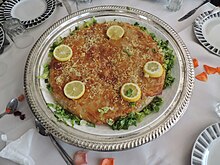
Seafood pastilla (Moroccan Arabic: بسطيلة الحوت) usually contains fish and other seafood, in addition to vermicelli. Unlike poultry pastilla, seafood pastilla is not sweet, but spicy.
Whereas poultry pastilla is dusted with powdered sugar and cinnamon, seafood pastilla is usually dressed with a light sprinkle of shredded cheese and a few slices of lemon.
This version of pastilla is often served at Moroccan weddings.[9]
Pastilla with milk[edit]
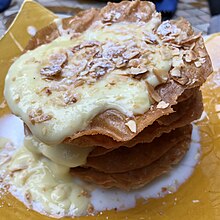
In the traditional Fassi cuisine, pastilla can also be served as a dessert, in which case, the pastilla is called Jowhara (جوهرة, jewel) or "Pastilla with milk". This pastilla is also made of warka and a milky cream put between the sheets. The Jowhara is flavored with orange flower water and decorated with cinnamon and sugar. [10]
Sephardic Jewish version[edit]
Among Moroccan Jews, pastilla is made with olive oil or margarine to follow kosher rules.
An increasingly popular variant makes individual pastries rather than large pies.[11]
See also[edit]
- Moroccan cuisine
- List of Moroccan dishes
- List of pies, tarts and flans
- Andalusian cuisine
- Sephardic Jewish cuisine
- Berber cuisine
- Pigeon pie [12]
References[edit]
| Wikimedia Commons has media related to Pastilla. |
- ^ Gaul, Anny (2019-11-27). "Bastila and the Archives of Unwritten Things". Maydan. Retrieved 2019-12-13.
- ^ "Migrations" (PDF). www.hommes-et-migrations.fr.
- ^ E.P. Lenderking. Tanjia Marrakchia: Culinary Adventure at Dar Les Cigogues. 2013.
- ^ Bastilla. Clifford A Wright. 2016
- ^ Don Philpott (20 October 2016). The World of Wine and Food: A Guide to Varieties, Tastes, History, and Pairings. Rowman & Littlefield Publishers. p. 278. ISBN 978-1-4422-6804-3.
- ^ Fodor's Travel Publications, Inc (2012). Fodor's Morocco. Fodors Travel Publications. pp. 19–. ISBN 978-0-307-92832-0.
- ^ "Pastilla Recipe - Bastilla Recipe - Delicious Techniques". norecipes.com.
- ^ https://www.196flavors.com/morocco-pastilla/
- ^ "في العرس المغربي: صناديق مبتكرة لتقديم الهدايا وطقوس عريقة". مجلة سيدتي (in Arabic). 2016-09-05. Retrieved 2020-02-21.
- ^ "Traditional Moroccan Food | Moroccanzest". Moroccanzest. 2018-07-28. Retrieved 2018-11-05.
- ^ Solomonov, Michael (2016). Zahav: A World of Israeli Cuisine. HMH.
- ^ "Did You Know: Food History - Bastila: a Culinary History of Morocco". www.cliffordawright.com. Archived from the original on 2015-02-20. Retrieved 2017-05-25.
